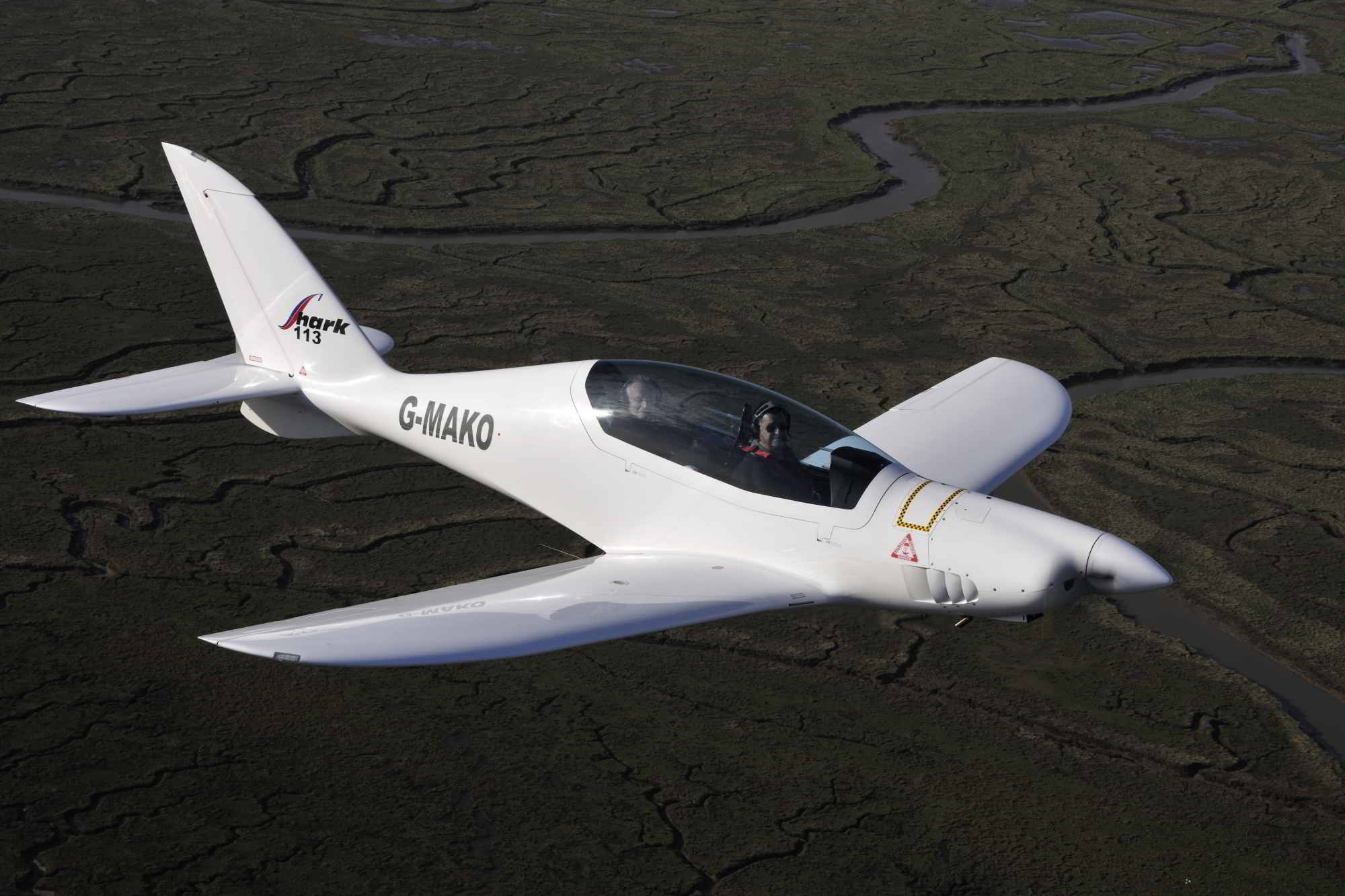
(Photo: Keith Wilson)
“You never get a second chance to make a first impression” is a wise old saw, and my initial impressions of the Shark were all very positive. Some aircraft look like they’re moving even when they’re standing still, and the Shark definitely falls into this category. From the tip of the sharp-looking spinner to the top of the swept-back fin, it’s easily the sexiest-looking microlight I’ve ever seen. Indeed, my first thought is that it looks rather like a scaled-down PC-21.
Walking around the aircraft, I note that the 100-hp Rotax 912S is very tightly cowled, and that access to the engine bay is adequate, but not outstanding, as quite a lot of Camloc fasteners need to be undone to remove the entire cowling for a full engine inspection. There’s a large electrically actuated NACA scoop in the bottom half which supplies air to the oil cooler and radiator, and small intakes in the top half on both sides of the spinner for cooling the cylinders. Hot air from the engine bay is exhausted through appropriately shark-like gills in the sides.
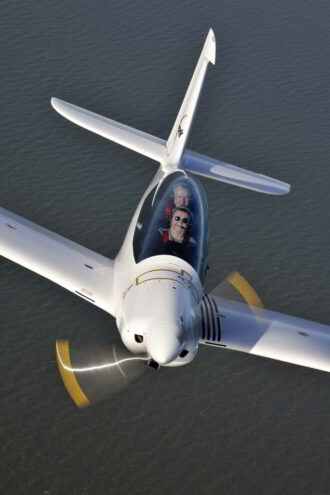
(Photo: Keith Wilson)
The oil dipstick is accessed through a small door in the top cowling, and there’s another small door for the movable ballast. Maintaining CG is always more critical in aircraft with tandem seating, and the Shark addresses this with a 13-pound moveable weight. When flown solo it goes in a special slot in the baggage bay. Flown dual, it must be in the engine compartment.
Despite the fact that it must always be fitted, it’s not included in the basic empty weight, which I thought was a trifle disingenuous. The motor is fed from two wing tanks with a combined capacity of 26 U.S. gallons (40 is an option), and spins a two-blade constant-speed Woodcomp propeller, which despite the name is made from carbon fiber.
The electrically actuated retractable tricycle undercarriage has a wide wheelbase and a reasonable wheel track. The nosewheel retracts aft, while the main legs are of a trailing-link design that retract inwards, fitted with Beringer wheels and hydraulic disc brakes. The wings and fuselage are constructed of carbon fiber with a honeycomb core, and the occupants’ “safety cell” is manufactured from a blend of carbon fiber and Kevlar aramid, the same as F1 cars. A unique carbon fiber process is used in the manufacture of the main spar. The wing uses a sophisticated laminar flow aerofoil—the ailerons extend right out to the tips and feature servo tabs. There are stall strips on the wing roots.
The tail consists of a swept-back fin which carries a horn-balanced rudder fitted with a ground-adjustable trim tab, and a tailplane with a slightly swept-back leading edge fitted with two-piece elevators. All the primary controls are actuated by pushrods except for the rudder, which uses cables. Pitch trim is provided by an electrically-actuated tab in the left elevator, and with the exception of the rudder, all the control surfaces are gap-sealed. Overall, it is extremely well made and finished to an extraordinarily high standard.
The Shark is obviously a slippery beast, so I wasn’t surprised to see that the electrically-actuated Fowler flaps have four settings: Up, 20, 30 and 38°. LED strobe and position lights are built into the wingtips and rudder, GoPro mounts are incorporated into the wingtips and tailplane.
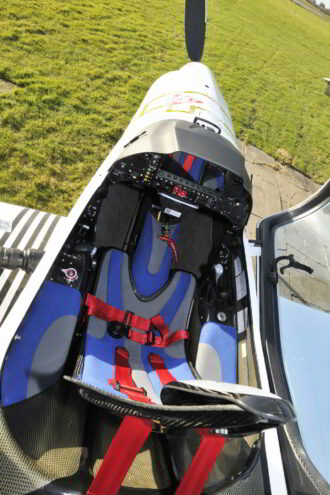
(Photo: Keith Wilson)
By now I was itching to find out if it was as fast as it looked—it was clearly time to go flying! Access to the tandem cockpit is good. There is a decent-sized non-slip walkway in the left wing root, while the big bubble canopy is hinged at the right side and again reminded me of the PC-21.
I took the front seat, and while TLAC Chief Test Pilot Howard Barber was strapping in, acquainted myself with the cockpit. The bubble canopy conveys that mini-fighter feel, and this is enhanced once you’re in the cockpit. Both the seat and pedals adjust—an unusual feature for a microlight, but as I was rapidly beginning to appreciate, this beast is a bit different to any other microlight of my experience. Even the seat adjustment is unique (at least to me). It’s on a sort of hydraulic ram, so before getting in, you press a button in the right-side console and it rises up. Then you sit on it, press the button and it slowly sinks. When it’s perfect for you, release the button, then adjust the pedals. Very slick.
Throttle and prop levers are on the left, with the fuel valve on the left armrest behind the throttle. Rotary knobs ahead of the side stick control heating and ventilation, with car-type vents built into the cockpit sidewalls.
Stowage is tight, and the baggage bay is obviously inaccessible in flight, but there are small storage compartments below each armrest, a narrow glove box below the instrument panel and a neat pen holder in the panel. A red T-handle fires the rocket for the Stratos Magnum parachute recovery system.
Overall, the snug cockpit is nicely laid out, and the controls are where you might reasonably expect to find them, as opposed to just being put where it’s easiest. However, there’s still room for improvement, which I’ll list at the end of the story.
Ready to Go?
To get started, turn the master on and use the rotary knob in front of the throttle to preset the adjustable air scoop in line with the ambient temperature. Press start and the Rotax fires instantly. The nosewheel steers through the rudder pedals, and the turn radius can be tightened by differential braking, an option many microlights don’t offer, being fitted with handbrakes. The powerful, progressive Beringer hydraulic disc brakes work well.
With two people on board and 14 gallons (84 pounds) of fuel and no baggage, I reckon we’re about 110 pounds below max gross. As I always do on the first flight on type, I open the throttle slowly. Directional control is fine, and acceleration adequate. Following Howard’s advice, as soon as I feel the elevator start to bite, I hold the nosewheel just off the ground, and the Shark soon slips into the sky having used about half of the 2200-foot runway. The ground roll felt slightly untidy, as the nose pitched and bucked a bit—I suspect it’s a lot easier on asphalt.
Now I encounter the Shark’s oddest facet. For reasons best known to the designers, the undercarriage uses airspeed to inhibit retraction, not “‘weight on wheels” microswitches. There’s a switch in the pitot-static system that prevents the wheels from retracting below 60 knots IAS, or above 76, irrespective of the undercarriage selector’s position. Having to maintain a 16-knot speed range simply to retract the undercarriage demands accurate speed control (76 knots is slower than the 81 knot Vy), and this is not helped by the low flap-limiting speeds. This is a solution searching for a problem, although once the undercarriage is extended the limiting speed is a heady 124 knots.
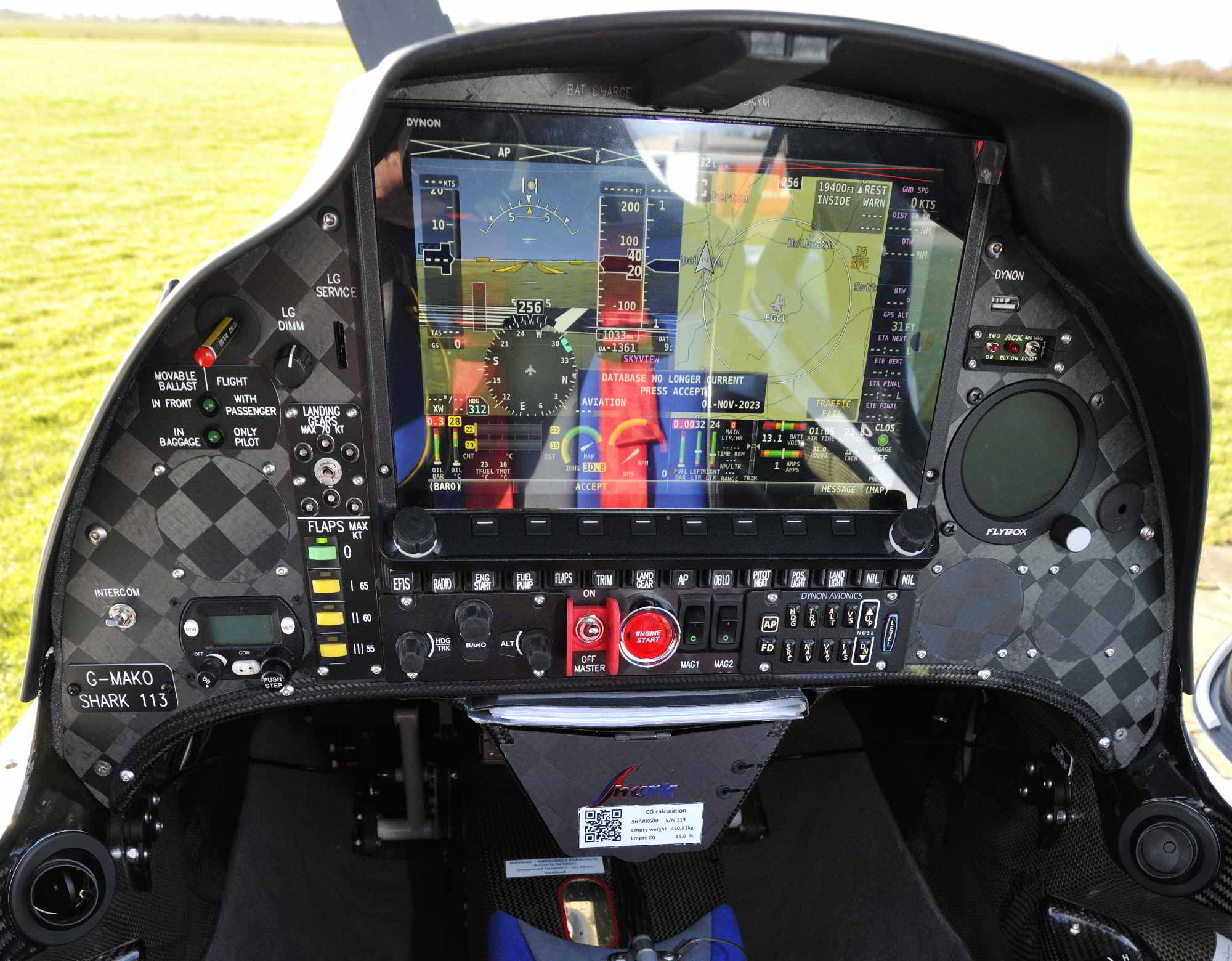
(Photo: Keith Wilson)
I haven’t flown with a sidestick for years, but I don’t even notice it. Even a cursory examination of the control and stability reveals that this machine is a real thoroughbred. The ailerons are light and powerful, the elevator authoritative and the rudder nicely balanced. Control harmony is also ideal, with the ailerons being the lightest primary control and the rudder the heaviest. Furthermore, all the primary controls are well weighted, with low breakout forces and very little stiction, even though the airframe only has 31 hours on it.
A more vigorous exploration of the flight envelope soon shows that it has a commendably rapid roll-rate for a microlight, and only small amounts of rudder are necessary to keep the slip-ball centered. It really is a shame that—being a microlight—aerobatics are forbidden. It’s also very stable and for a relatively light aircraft, feels like a heavier machine. In fact, when I try some 60° banked turns, it almost feels like it’s on rails. All you have to do is put the nose just above the horizon, roll on loads of bank and then reef it around. When maneuvering aggressively, I was extremely grateful for the excellent field of view conferred by that giant canopy. It really is outstanding—only modern sailplanes and fighters come close. Thinking about gliders, I pull the power to idle and examine the glide angle, and at 70 knots, it’s quite flat, with a relatively nose-up attitude and a sink rate of only around 300 fpm.
A look at the stick-free stability reveals it to be positive longitudinally and directionally. Having trimmed for 100 knots, I ease back on the stick until the speed drops to 90 and then release it. After only two long-wavelength, low-amplitude phugoids, it returns to the trimmed speed. It’s nicely damped in pitch, and also in yaw. Spiral stability is essentially neutral, being neutral to the left and just faintly positive to the right (because of the engine and prop).
Time for some slow flight and stalls, and the only problem is that as it is quite slippery, it’s reluctant to decelerate, a problem exacerbated by the low flap and undercarriage limiting speeds. Vfe is 76 knots, but the flap control system also has a switch in the pitot-static system, this one prevents the flaps being lowered above 70 knots.
In complete contrast to both the Shark’s appearance and its name, it doesn’t bite, and slow flight is very benign; although a downside is that the pre-stall buffet is very subtle. Flaps up, it stalled at 41 knots IAS and broke to the right. With full flap, it was an impressively slow 35 knots, and this time broke left. However, I suspect significant position error here, as the POH gives a Vs of 47 and a Vso of 40 at MTOW. Recovery is very easy, with minimal loss of altitude.
Accelerating out of the final stall, I set 5000 rpm and 26 inches manifold pressure (76% power), trim forward and let the Shark accelerate. This is “fast cruise” and the indicated airspeed soon stabilizes at 140 knots, which is very impressive on only 100 hp. At this power setting and 5000 feet it will true out at an impressive 150 knots for a fuel flow of around 5.3 gph. Although blisteringly fast by microlight standards it’s also quite thirsty, and a more representative power setting of 4300 rpm/24 inches (economy cruise, 55%) still gives a TAS of 140 knots at 5000 feet, but at a much better 4 gph.
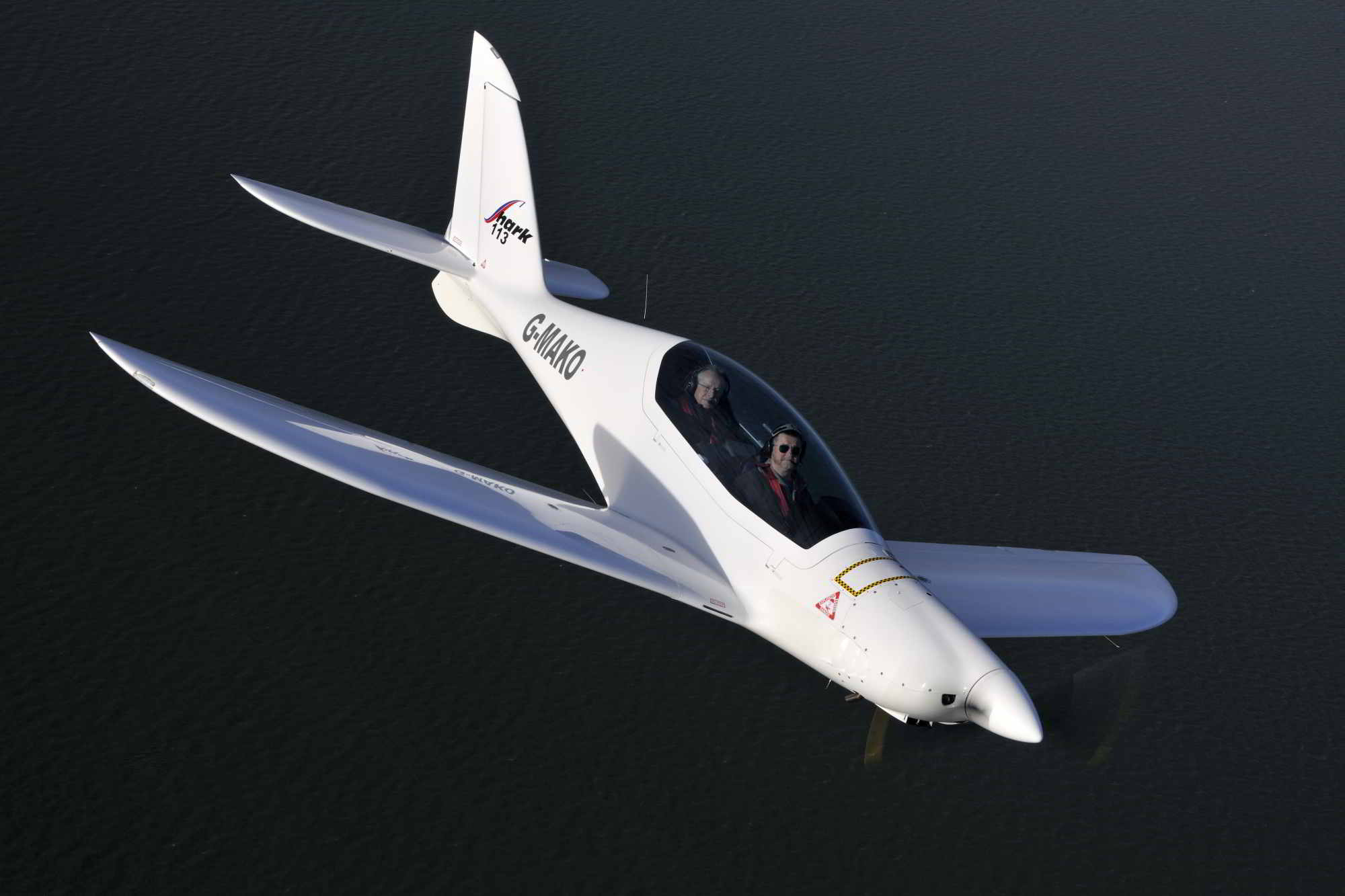
(Photo: Keith Wilson)
By now I was eager to assess the Shark in the circuit, and as the flap and undercarriage limiting speeds are a bit too low, it’s not easy to slow down. If you’re close to the airport and hot ‘n’ high, it may embarrass you. Essentially, you cannot go down and slow down; it’s one or the other! Pilots who have trained on draggier would have to monitor the Shark’s energy level (speed and height) very carefully, particularly as you can’t use the undercarriage or flaps to slow down.
Once correctly configured, it’s quite speed stable, and lowering full flap pitches the nose down slightly, but the pitch-trim loads don’t change, as the elevator pushrod in the baggage compartment is connected by cables and springs to the flap control system and adjusts automatically, making trim changes minimal. However, it’s still very important to watch the attitude and airspeed, as even lowering the nose by a couple of degrees produces an increase in speed.
During the briefing, Howard had said: “Don’t hold off fully. Just arrest the sink rate over the numbers, hold the nose up slightly and wait. And don’t over-rotate.” I can feel him guarding the stick as he said he would, and yes – I try to sweeten the touchdown and almost touch the tail bumper! The go part of the touch and go is great—just watch those speeds (it took me two goes to get the undercarriage up). My second landing is firm but fait and Howard approves. On my next approach I leave the flaps at 2, which gives me a slightly protracted float, and as I now have the correct pitch picture for the flare in my mind the touchdown is gratifyingly smooth, and we still make the intersection turnoff with no brakes.
Obviously, I loved it. The ergonomics need work, but the fine handling and sexy looks are undeniable, as is the excellent performance.
About Those Ergonomics
As mentioned at the beginning, the Shark could use some refinement in the cockpit and warning systems. To wit:
- I’d suggest making the parachute recovery system’s handle a black and yellow striped loop (like an ejection seat), which would make the cockpit look even more like a fighter’s.
- The sidestick could use one of those Infinity stick tops with all the buttons, and possibly even on the throttle as well. The HOTAS thing isn’t pure aesthetics though. The low flap speed means that on a go-around you need to get the flaps moving almost as soon as the throttle hits the stop, so a pistol grip on the throttle could incorporate switches for the flaps, transponder ident and transceiver flip-flop to compliment the buttons on the sidestick for electric trim, push-to-talk and autopilot disconnect.
- The prop lever should be blue, and the undercarriage selector needs more presence. It’s operated by a small toggle switch that is essentially the same as the intercom selector but is sprung to neutral, which means that its position provides no visual clue as to what’s supposed to be happening.
- The undercarriage and flap annunciator lights also need work. With all three wheels locked down, “three greens” is traditional. Wheels out of the wells and unlocked, red is the accepted convention. Up and locked: no lights illuminated. Instead, the Shark has three green and three red lights, and when I flew it, the red lights flashed when the undercarriage was unlocked, but also flashed if the airspeed dipped below 100 knots when the wheels were locked up, and stayed on red when the wheels were up. This has subsequently been improved since my flight test. Upon retraction, the red lights now go out after five seconds, and the green lights flash and a horn sounds if the airspeed reduces below 67 knots with the wheels up. This is good, but would be better if the red lights flashed.
- The flaps are currently selected by pressing the appropriate yellow button, which flashes until it reaches the selected setting, then stays on. However, if it senses you’re approaching Vfe (and that’s very easy to do) it also flashes, which is confusing.
- A pair of green LEDs indicates the position of the moveable ballast, and one of these also remains illuminated in flight. It would be better if the ballast system was arranged so if there is a mismatch between the number of occupants and the ballast’s location, the engine simply won’t crank. Four microswitches, some wire and a solenoid is all you need. The green LED which shows the weight’s position doesn’t need to be on once the engine has started, and could even be deleted.


Great except for the price. Yes< i get that there is "carbon fiber" like in "an f1 car." A honda civic has carbon fiber, so do some parts on my v10 ford van. Its a single mold for the pilot and passenger. Not exactly rocket science and unheard of. So I don't know why this is a big deal.
Great performance for a small plane, everything is modern and advanced. When I saw order prices tipping $400K then I got far less enthusiastic. This isn't a CERTIFIED aircraft. at best an experimental that gets a nod from Mosaic rules maybe in 2025 in the US. But again, this is an experimental aircraft without the rigors of certification, yet they drop a $400k price tag on it.
I sense the excitement will quickly wane for this aircraft in the United States. A few select buyers who already have certified capable 200+knot aircraft that will want this for another toy.
At this price point it will be just like any other aircraft as far as sales. it won't bring new pilots or even new enthusiasts to aviation, as acquisition cost are, at present, out of reach for the target market.
One wonders how many middle men, writers such are yourself and middle salesmen need to get paid in the US just to sell one of these. I bet it is more than a few. Looks like a good plane, I don't think they will sell too many but we can see.
My main point is that they tout the price as being because it has "many" hand crafted and purpose built parts. Again this is no huge selling point, all aircraft need this attribute to their construction. Are they some special aircraft builders from another Galaxy? no, they are just normal people working in a factors, like in factories all over the world. Probably making 4.23 per hour or less in the Czech republic and not justifying the huge price markup of this "could have been a great" value aircraft.
Certified, made in the USA, ok maybe the price is justified. However, made by some home-boys and home-girls in eastern europe for pennies doesn't mean I want to pay a ridiculous markup on labor or their self-terms genius ideas. did you see the women in their factory squeegy-ing the fiber layups? Did they look unusually highly skilled or did they look like some guys wife or girlfriend that got tired of cleaning houses ? Not even a "clean room" to temperature and particulate control the manufacturing process. Very, very amateurish. So where is the amateur price tag? Wait, now those girls in the shop are "skilled craftsman." That will be $400,000 please.
Interesting comments from the author, as an owner I have been really impressed with the clever and innovative design features. Some of the feedback given lacks understanding of why things are the way they are. Owners get it after a brief transition period, and it all falls into place.
The gear enunciation system has already been updated to behave in a more conventional manner, but having never previously owned a plane with retracts, the system did exactly what it should do without any confusion for me. I can see how a newbie would be expecting something different. In many ways I am delighted that my Shark has innovated instead of replicated. If traditional systems were so great, why are insurance companies writing off planes due to gear up landings all the time?
You can thank the German authorities for the ballast system. In hind sight I would have elected to omit it altogether and limit the back seat passenger weight.
Vlado and his team have a phenomenal product with a performance envelope that none can match with the same engine. Keep your flashy paint jobs and super car interiors – I’ll take the comfort and performance, and I can’t wait to see what other new innovations come out of their R&D!
Many Thanks for Your final comments :
Some of that Your notices are identical like our comments to company owner Vlado Pekár ten years ago or more …
OUR = a twenty friends, aircraft specialists, created Shark design for him …
No one is in actual Shark team from us by my information.
Actually it is almost 15 years from Shark’s first flight (19th August 2009) – performed (and officially declared) as collaboration between Vlado’s company COMP-LET, later Shark.aero – and Gryf design team …
http://www.facebook.com/photo/?fbid=2457445390950629&set=a.2457083997653435
and items like “movable ballast” – was not included in type certificated UL version of Shark – with smaller EW, and calculated that time for 600kg MTOW too…
= so there is not needed to do next development – but return to our original ideas
Excellent, informative article. Thanks.
Sounds alot like the lightning right Jack?!